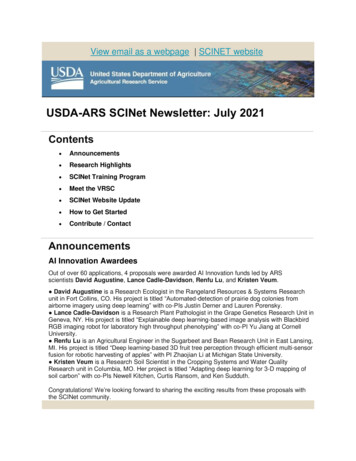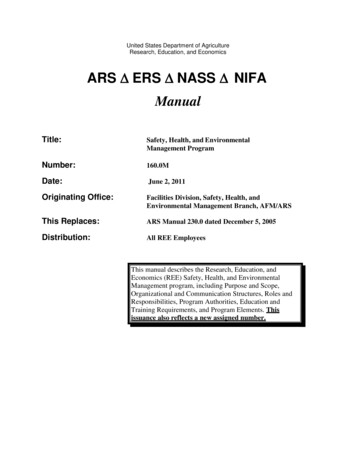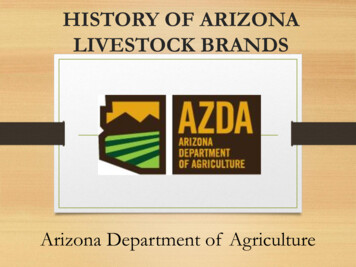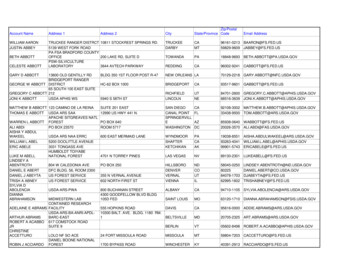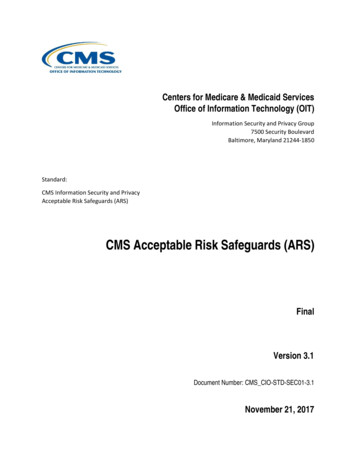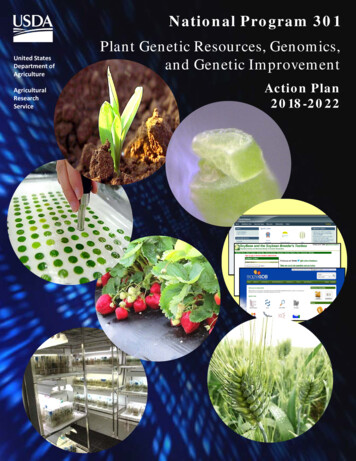
Transcription
View email as a webpage SCINET websiteUSDA-ARS SCINet Newsletter: October 2020ContentsHow to Get StartedSCINet Website UpdateSCINet User TipsSCINet Training ProgramResearch HighlightsMeet our SCINet FellowsNew ToolsContribute / ContactHow to Get StartedSimply request a SCINet account (eAuthentication required) to getstarted. Upon approval, you will receive instructions for logging intoSCINet and accessing Basecamp.Check out the SCINet website for more info on how SCINet can enableyour research.Read the SCINet FAQs covering general info, accounts/login, software,storage, data transfer, support/policy/O&M, parallel computing, andtechnical issues.SCINet Website Update
New content is constantly being added to the SCINet website. Please send any websitefeedback to SCINet-Newsletter@usda.gov.SCINet User TipsLarge short-term data storage:If your analysis requires a lot of temporary disk space that is above your projectdirectory quota, you can use unlimited short-term storage/90daydata/your project name. Files older than 90 days will be automaticallydeleted.You can also use /90daydata/shared to share data with other users that don’t haveaccess to your project directory. Note that anyone on the system will be able to readthat data.R users:If you have functions that you always want to have when you start a new session in
R then you can place those functions into an .Rprofile file in your home directory: /.Rprofile.One useful function if you use R from the terminal and not in RStudio is thewideScreen function. This function will set the text wrapping to the width of yourterminal:wideScreen - function(howWide Sys.getenv("COLUMNS")) {options(width as.integer(howWide))}Do you have tips to share?Email them to SCINet-Newsletter@usda.gov to be included in future newsletters.SCINet Training ProgramSCINet-funded Training:The SCINet Geospatial Research Working Group held a series of workshopsand training sessions in August and September 2020 to make progress on workinggroup technical projects, provide hands-on learning experience using the ARS Cereshigh-performance computing (HPC) system, and inspire new research ideas. Thesessions included 1) an annual meeting of the working group, 2) HPC and linuxbasics tutorial, 3) Python Dask for distributed computing tutorial, 4) computationalreproducibility and collaboration with Git, Conda, and containers tutorial, 5) machinelearning using gradient boosting from scikit-learn tutorial and 6) a symposium on theuse of AI techniques in agricultural research. Almost 90 ARS scientists, scientificstaff, and University collaborators representing many different disciplines and ARSNational Programs were in attendance. Detailed information on all the sessions,including the tutorials (which anyone can work through at their own pace), can befound on the session tabs of the SCINet Geospatial Research Workshop 2020website. Recordings will be posted soon.SCINet supported online Carpentries Workshops were offered in July and August2020. These were a series of 4, 2-day workshops, which provided scientists andsupport staff with hands-on instruction to become more comfortable at the commandline, introduce them to document version control with Git, and start them on the pathto building their coding skills, in either R or Python, so that they can better utilize theUSDA computing resources available to them for their research. Almost 80scientists, post-docs, and collaborators attended these workshops. Please look forfurther Carpentry trainings in FY21 to be featured on the Upcoming Events page.Coursera.org certified courses update: The SCINet initiative has purchased 75licenses and the AI Center for Excellence has purchased 50 licenses for ARSresearchers to take Coursera courses with certification. Information about how to
obtain a license is expected to be emailed soon and will be posted on the FreeOnline Training page of the SCINet web site.Free Online Computational Training (Self-paced)Make use of your work-from-home time with computational training! A large list offree tutorials and courses has been compiled on the Free Online Training page.Training topic areas include Python, R, SAS, and MATLAB programming; statistics;data science concepts; AI and machine learning; GIS; Google Earth Engine; Git andGitHub; reproducibility, productivity, and integration management tools; andbioinformatics and ecology domain learning. Know of additional free trainingopportunities? Send them to SCINet-Newsletter@usda.gov.SCINet Online Science TutorialsBrowse our growing set of SCINet science tutorials created by ARS scientists and theSCINet Virtual Research Support Core. Our ARS Science Tutorials page includes CeresOnboarding and Intro to Unix for new HPC users, two geospatial computing tutorials, aQTL Analysis tutorial for sequencing in R, and machine learning training material.Research HighlightsAsian giant hornet genome quickly sequenced by SCINet’sAg100Pest Initiative working groupImage from Brian Scheffler
The Asian giant hornet is invasive to North America and could potentially threaten nativebee populations and pollination pathways. The first Asian Giant hornet nest was found inNorth America in September 2019. After receiving DNA from a hornet in that nest in May2020, researchers in the SCINet Ag100Pest Initiative working group (a subgroup of theArthropod Genomics Research (AGR) working group) used SCINet computing resources toquickly produce a reference genome assembly by the end of June.Conducted as part of the Ag100Pest Initiative, the quick turnaround time from obtaining thesample to producing the genome assembly is promising for invasive insect managementsuch as pinpointing where the nest in Canada originated from. The genome is publiclyavailable in the AgDataCommons and more information can be found here in a recentUSDA ARS Press Release.Simulations to help constrain experiments: identifying genes withhigh potential to increase crop yieldsBy Justin VaughnMany technological developments made the Green Revolution possible, including selectivebreeding to promote specific plant genes that increased crop yields. For example,substituting the common version of the oxidase gene with a broken version (sd-1) in riceled to plants of shorter stature, which facilitated mechanized farming and a resultant stepchange increase in food yield (Spielmeyer et al., 2002). Today, opportunities to use plantgenetics to maximize crop yields are greater than ever. Geneticists can generate largesuites of different versions of any gene using CRISPR-Cas9 technology. The history of sd-
1 suggests that such capacity will have a profound impact on agriculture and global foodproduction. Unfortunately, there remains a critical gap in our ability to discover which geneswe should target for such exploration.The USDA’s Genomics and Bioinformatics Unit uses genomics and phenomics to improvethe efficiency of identifying genes with high potential to increase crop yields. Computersimulations of controlled crosses allow researchers to explore experimental scenarioswithout the time, expense, and manual labor associated with physical experiments. Wedeveloped software, QTLsurge, to simulate specific kinds of experiments. QTLsurge runsin the R statistical programming environment, so it can be used on a local computer or aremote cluster like Ceres. We also developed an open source simulation platform,crossword, that can be used for a broad range of crops and breeding systems (Korani andVaughn, 2019). Unlike many available tools, crossword accepts empirical genomics dataas a starting point and thus gives an accurate and directly applicable reflection of likelyexperimental outcomes.Our simulations supported the commonsense prediction that larger populations offer muchmore capacity to finely resolve genes. Importantly, this signal is not masked byexperimental noise. Less intuitively, for large populations, phenotypic replication wasunnecessary and the number of extreme individuals needed for sampling could vary from5% to 20% without affecting resolution. These results have a substantial impact onreducing the manual labor required for experiments of this scale.SCINet Note: This study required substantial computational resources to simulate hugepopulations across a range of parameter sets. The full study assessed 5,000 parametercombinations and required thousands of CPU hours. While this effort would have takenyears on a personal computer, we were able to get results in three weeks by distributingjobs across a subset of Ceres CPUs. For more information about using SCINet for plantbreeding research, visit the SCINet website.References:Korani, W., Vaughn, J.N. 2019. Crossword: A data-driven simulation language for thedesign of genetic-mapping experiments and breeding strategies. Scientific Reports 9,4386. er, W., Ellis, M.H., Chandler, P.M., 2002. Semidwarf (sd-1),“green revolution” rice,contains a defective gibberellin 20-oxidase gene. Proceedings of the National Academy ofSciences 99 (13), 9043-9048. https://doi.org/10.1073/pnas.132266399
Identifying crop phenology with deep learningBy Shawn Taylor* and Dawn Browning*Shawn is one of 10 postdocs in SCINet’s first postdoc cohort. Scroll down to our new"Meet our SCINet Fellows" section below for a short introduction to Shawn and otherfeatured fellows Jennifer Chang and Yanghui Kang.There is an enormous amount of data currently being generated to research best practicesfor agriculture. Satellite data, imagery from drones and near-surface cameras, sensor datafrom meteorological stations and eddy covariance towers, and traditional groundobservations are among the data continuously collected across the 18 sites in the LongTerm Agricultural Research (LTAR) Network. Combining different data sources canpotentially provide insights which are not possible using any single source, but harmonizingthese diverse sources is a challenge due to differences in temporal and spatial resolution.The SCINet LTAR Phenology Working Group is exploring methods and limitations to largescale data integration from multiple sensor arrays available to ARS scientists.One sensor system, the PhenoCam network, is a global array of near-surface camerasused to track vegetation processes by looking down on the canopy. With hundreds ofcameras taking up to 48 photos a day, this data stream has provided novel insights intomany biological processes, yet also presents a big data challenge (Kosmala et al. 2018).The primary output from PhenoCam imagery is a greenness metric which correlates wellwith above-ground plant processes in most areas, but can provide confounding signals inagricultural fields due to practices like harvest timing and crop rotations.
One under-used aspect of PhenoCam images is their contextual information which caninclude crop type and timing of management activities. With millions of PhenoCam images,identifying these features by hand is impossible. We combined PhenoCam images withdeep learning methods to automatically identify crop stages such as timing of emergence,flowering, and harvest. Crop phenology, or the timing and duration of discrete crop stages,can be used to complement data or metrics from other sensors. For example, daily carbonfluxes estimated via eddy covariance measurements could potentially be partitioned bycrop stage, which before would have required destructive sampling throughout the growingseason. Croplands cover a large portion of the land surface, and so crop phenology is vitalto understanding large-scale greening patterns across the globe. The ability to identify cropphenology in a scalable, repeatable, and automated way using millions of imagesrepresents an agricultural innovation that can be used to develop a global database of cropphenology observations (Hufkins et al. 2019). This database could be used to verify modeloutputs in regional to global remote sensing studies or large-scale research of carbondynamics.SCINet Note: We used the Ceres HPC to train a deep learning image classification modelto identify the crop stage from PhenoCam images. Ceres was then used to classify140,000 individual images from LTAR locations totalling 54GB of data. Our model wasderived from open source deep learning models implemented in the Python TensorFlowpackage.References:Hufkens K., Melaas E.K., Mann M.L., et al. 2019. Monitoring crop phenology using asmartphone based near-surface remote sensing approach. Agricultural and ForestMeteorology. 265:327–337. mala M., Hufkens K., Richardson A.D. 2018. Integrating camera imagery,crowdsourcing, and deep learning to improve high-frequency automated monitoring ofsnow at continental-to-global scales. PLoS One 9649Do you use SCINet for your research?Contact SCINet-Newsletter@usda.gov for a chance to be featured in the newsletter!Meet our SCINet FellowsHere are introductions to a few of SCINet’s first cohort of postdoctoral fellows. SCINetpostdocs are tasked with developing cross-site collaborative research projects that utilizethe ARS SCINet high-performance computing resources. They will also contribute to nonresearch projects that further the SCINet Computing Initiative such as the SCINet website,newsletter, and various computational trainings. We will continue introductions in upcoming
issues of the SCINet newsletter. First up we have Jennifer Chang, Yanghui Kang, andShawn Taylor.Jennifer Chang, Bioinformatics ScientistJennifer Chang grew up in Wisconsin and has beenprogramming since 2006. At Cornell College, she doublemajored in Biochemistry and Computer Science graduatingin 2011. In 2017, Jennifer earned a Ph.D. in bioinformaticsfrom Iowa State University. During her Ph.D., her researchsoftware “Mango Graph Studio” led to co-founding asoftware company and working on two Department ofDefense Small Business Innovation Research (SBIR)contracts. She eventually left the company and was apostdoc with Dr. Amy Vincent at USDA-ARS, automatingswine influenza reports from 2017-2020. In June 2020, Jennifer shifted to a SCINetpostdoc position with Dr. Andrew Severin and Dr. Brian Scheffler where she collaborateson the bioinformatics workbook. She’s still in Ames, Iowa, learning slurm and automatingpipelines for different hardware architectures. She hopes to write flexible general-purposepipelines that reduce tedium and increase joy of discovery. Jennifer cares aboutcollaboration, welcoming environments, and teaching.Yanghui Kang, Physical ScientistYanghui started her SCINet Postdoc position in May 2020after receiving a Ph.D. degree in Geography from theUniversity of Wisconsin-Madison. She works with Dr. FengGao and Dr. Martha Anderson at the Hydrology andRemote Sensing Laboratory in the Beltsville AgriculturalResearch Center, Beltsville, Maryland. Yanghui’s researchprojects have focused on the large-scale high-resolutionmonitoring of core agroecosystem variables (e.g., LeafArea Index (LAI), crop yield), with the help of satelliteremote sensing, machine learning, crop growth modeling,and data assimilation techniques. At ARS, Yanghui is currently developing a machinelearning-based approach to map LAI from Landsat and Sentinel-2 images over the entireglobe. She is also interested in deriving crop phenological stages from satelliteobservations and monitoring agroecosystem dynamics through data assimilation. Yanghuiis bringing her experience working with big data to construct a SCINet common data libraryfor the geospatial community, allowing us to optimize storage space on our HPCs.Shawn Taylor, Ecologist
Shawn obtained his Ph.D. from the University of Florida in2019, where he researched best practices in ecologicalforecasting and implemented a continental-scale phenologyforecast. He is currently a postdoc at the USDA-ARSJornada Experimental Range in Las Cruces, NM workingwith Dr. Dawn Browning, and will transition to his SCINetpostdoc in October. Shawn is a member of the SCINetLTAR Phenology Working Group and participated in a 2019workshop in Las Cruces, NM focused on devisingcollaborative workflows on the SCINet high-performancecomputing (HPC) system, Ceres. He is currently integrating large streams of sensor dataacross the Long Term Agricultural Research (LTAR) network to help promote increasedproduction and sustainability.New ToolsReads2Resistome streamlines the process of turning a bacterial culture into an informativeannotated genome, performing both genome assembly and in-depth genomecharacterization. Users with experience in Linux basic commands can analyze bacterialgenomes sequenced using either short and/or long read sequencing technologies.Reads2Resistome takes fastq reads as input and performs assembly, annotation andgenome characterization with the goal of producing an accurate and comprehensivedescription of the bacterial genome and collection of all the antibiotic resistance genes,virulence genes, and other resistance elements within the chromosome, plasmids orbacteriophage.Contribute / ContactFor questions about this newsletter, to contribute content, feedback on the SCINet website,or SCINet policy and development questions please email SCINet-Newsletter@usda.gov.For technical assistance with your SCINet account, please email scinet vrsc@usda.gov.SCINet Leadership TeamDeb Peters, Acting Chief Science Information OfficerStan Kosecki, Acting SCINet Project ManagerAdam Rivers, Science Advisory Committee (SAC) ChairBrian Scheffler, Ex OfficioSCINet Website Comments
Stay Connected with the USDA Agricultural Research Service5601 Sunnyside Avenue, Beltsville, MD 20705This email was sent to Email Address using GovDelivery Communications Cloud, on behalf of: USDA Agricultural Research ServiceUSDA is an equal opportunity lender, provider, and ns/2688427/editPage 11 of 11
National Programs were in attendance. Detailed information on all the sessions, including the tutorials (which anyone can work through at their own pace), can be found on the session tabs of the SCINet Geospatial Research Workshop 2020 website. Recordings will be posted soon. SCINet supported online Carpentries Workshops were offered in July .
